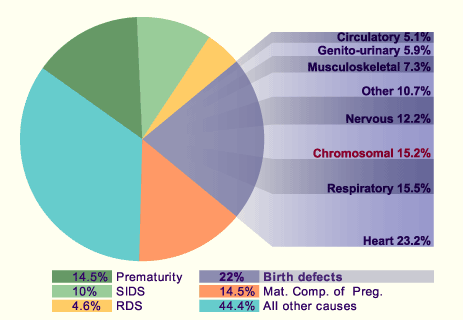|

|
|
|
11.0 Learning aims, what you should already know, introduction, delving deeper
|
|
|
|
The student gains knowledge about the following topics:
- The difference between various kinds of chromosomal aberrations and gene mutations
- Possible causes of such disorders
- Interactions between genotype and the environment
- Polygeny and abnormalities
- General clinical symptoms of chromosomal aberrations
|
|
|
What you should already know
|
|
|
|
Mutations are alterations in genetic material that affect either all of the chromosomes, chromosome segments, or even single genes. At the molecular level an altered (or mutated) DNA base sequence is thereby involved. Depending on how they arise one subdivides mutations into spontaneous and induced ones. Spontaneous mutations occur under "normal" conditions with a certain probability. The rate for them, however, varies individually. In contrast, induced mutations arise through the effects of physical, chemical or viral noxae.
|
|
|
|
Chromosomal aberrations:
Most chromosomal aberrations arise randomly as the gametes are formed. Following fertilization such embryos mostly do not develop correctly and result in a spontaneous miscarriage. Examinations of embryos from miscarriages have shown that ca. 50% exhibit chromosomal aberrations.
A small portion of chromosomal deviations occur after the fertilization in a cell line. Those thus affected can for this reason exhibit a mosaic form (some cells with deviations and some without). Chromosomal mutations can also, though, be handed down from the parents to the offspring even though the parents are phenotypically healthy, i.e., they have balanced genetic material. An example of this is translocation.
|
|
|
|
Gene mutations:
Most of these mutations lead to missing gene products or products that are unable to function. In rare cases, however, a mutation can also bring about the synthesis of a "better" protein, i.e., one that is better suited for the environmental conditions. This organism has an advantage and, via natural selection, the modified gene will ultimately replace the original gene in the majority of the population. Evolution, the development of the variety of life forms, would not have been possible without mutations.
Much more frequently, though, such mutations lead to inheritable and/or to newly appearing diseases of which ca. 5000 are known. Looking at the death statistics of newborns (Fig. 1), one sees that congenital abnormalities (birth defects) comprise more than one fifth of all fatalities among newborns and infants.
|
|
|
More info
|
|
Resistance to malaria depends on a gene FY-0 that, in contrast with its allele gene FY-1, is unable to synthesize the protein that makes it possible for the malaria parasite to enter into the erythrocytes.
Details
|
|
|
| Fig. 1 - Overview of the causes of deaths in newborns and infants (USA 1998) |
|
Legend |

RDS
SIDS
Mat. Comp. of Preg.
|
Respiratory distress syndrom
Sudden infant death syndrom
Maternal components of pregnancy
|
|
|
|
Fig. 1
The overview shows that in the USA the congenital abnormalities (blue) comprise 22% of all the fatalities at birth or in newborns. Of these, the largest portion consists of cardiac abnormalities followed by lung abnormalities and chromosomal aberrations.
Among the "other 10.7%" are all the rest: those birth defects that cannot be categorized or combined.
(Source: National Center for Health Statistics, USA, 1998)
|
|
In the literature one finds a large variety of figures regarding the percentages of the various categories of congenital abnormalities. This results from the fact that many chromosomal aberrations exhibit abnormalities in one or several organs.
In the future with more refined techniques still more congenital illnesses from chromosomal and gene mutations will be found.
|
|
|
- What are mutations?
- Which influence does gene research have regarding congenital diseases and abnormalities?
- How is it possible for chromosomal aberrations and gene mutations to occur?
- How can wrong chromosome distributions in forming gametes happen?
- Can environmental factors influence the genotype?
|
|
|
|
|

